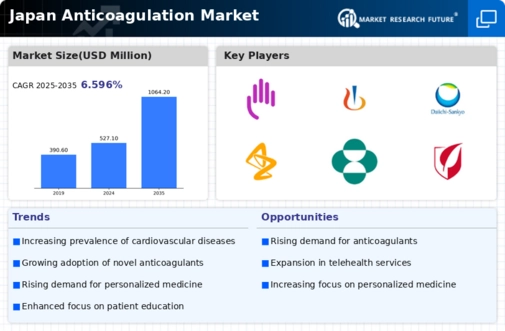Technological Advancements in Anticoagulation Therapies
Technological innovations in anticoagulation therapies are reshaping the landscape of the anticoagulation market in Japan. The introduction of novel oral anticoagulants (NOACs) has revolutionized treatment protocols, offering patients more convenient options with fewer dietary restrictions and monitoring requirements. The market for NOACs in Japan is expected to grow at a CAGR of around 8% through 2025, driven by their efficacy and safety profiles. Additionally, advancements in drug delivery systems and personalized medicine approaches are likely to enhance patient outcomes, further stimulating market growth. These technological advancements not only improve treatment adherence but also expand the therapeutic options available to healthcare providers, thereby influencing the overall dynamics of the anticoagulation market.
Increased Healthcare Expenditure and Access to Treatments
Japan's healthcare expenditure has been on the rise, which positively impacts the anticoagulation market. The government has been investing significantly in healthcare infrastructure, aiming to improve access to essential medications and treatments. In 2025, healthcare spending is projected to reach approximately $500 billion, reflecting a commitment to enhancing patient care. This increase in expenditure facilitates better access to anticoagulant therapies, particularly for patients with chronic conditions requiring long-term management. Moreover, the expansion of health insurance coverage for anticoagulants is likely to further drive market growth, as more patients gain access to these critical therapies, thereby enhancing the overall landscape of the anticoagulation market.
Regulatory Environment Favoring Anticoagulant Innovations
The regulatory environment in Japan appears to be increasingly supportive of innovations in the anticoagulation market. The Pharmaceuticals and Medical Devices Agency (PMDA) has streamlined the approval process for new anticoagulant therapies, encouraging pharmaceutical companies to invest in research and development. This regulatory support is crucial for bringing novel therapies to market, which could address unmet medical needs and improve patient outcomes. As a result, the anticoagulation market is likely to witness a surge in new product launches, enhancing competition and providing patients with a broader range of treatment options. The favorable regulatory landscape may also attract foreign investments, further stimulating growth in the sector.
Growing Awareness and Education on Thromboembolic Disorders
The growing awareness and education regarding thromboembolic disorders among healthcare professionals and patients are pivotal drivers for the anticoagulation market in Japan. Initiatives aimed at educating both the public and medical community about the risks associated with conditions like atrial fibrillation are gaining momentum. This increased awareness is likely to lead to earlier diagnosis and treatment, thereby expanding the patient base for anticoagulant therapies. Furthermore, educational campaigns are expected to enhance patient compliance with prescribed anticoagulant regimens, ultimately improving health outcomes. As awareness continues to rise, the demand for effective anticoagulation solutions is anticipated to grow, positively influencing the market dynamics.
Aging Population and Rising Incidence of Cardiovascular Diseases
The aging population in Japan is a critical driver for the anticoagulation market. As individuals age, the risk of developing cardiovascular diseases, such as atrial fibrillation and venous thromboembolism, increases significantly. According to recent statistics, approximately 30% of the Japanese population is projected to be over 65 years by 2030, leading to a higher demand for anticoagulant therapies. This demographic shift necessitates effective management of thromboembolic disorders, thereby propelling the growth of the anticoagulation market. Furthermore, the increasing prevalence of lifestyle-related diseases, such as hypertension and diabetes, further exacerbates the need for anticoagulation treatments, indicating a robust market potential in Japan.

















Leave a Comment